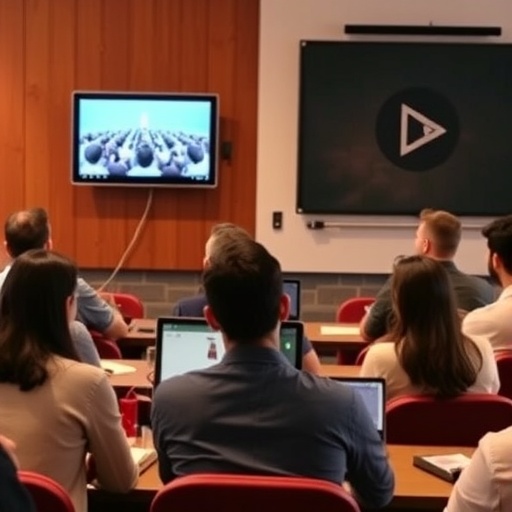In a groundbreaking study published in BMC Medical Education, researchers have ventured into the heart of medical pedagogy by contrasting the efficacy of integrated video-based learning against traditional didactic lectures among the cohort of Indian medical graduates. This multicentric study illuminates a key question in medical education: Can innovative technology enhance learning outcomes for future healthcare professionals? As the landscape of education continues to evolve, such inquiries become crucial in preparing the next generation of doctors for the complex, interconnected challenges of modern medicine.
The study draws attention to the limitations of conventional teaching methods, which have been the backbone of medical education for decades. While lectures have served their purpose, the rise of digital technology has prompted educators to explore alternative methodologies that not only engage students but also enhance retention and application of knowledge. This is where video-based learning comes into play, offering an interactive and dynamic alternative that is increasingly being integrated into curricula worldwide.
In conducting this study, the researchers utilized a robust methodology, implementing a randomized control trial across various medical institutions. Medical graduates were divided into two groups: one receiving the conventional didactic lectures and the other engaging with integrated video-based modules. The innovative nature of the study design was pivotal in ensuring the reliability of the results, allowing for a direct comparison between the two educational approaches.
One of the most significant findings of the study was the marked difference in student engagement levels. Those participating in the video-based learning program reported a greater sense of involvement and interest in the material being presented. This aspect is particularly important in medical education, where the ability to remain engaged can significantly impact learning outcomes. Engaged learners are not only more likely to retain information; they are also better equipped to apply their knowledge in real-world scenarios.
Moreover, the study revealed differences in knowledge retention between the two groups. Students who engaged with video content demonstrated higher retention rates in assessments conducted after the completion of the educational modules. This finding underscores the potential effectiveness of incorporating multimedia resources into learning environments, particularly in a field as demanding as medicine. The adherence to instructional quality is essential, and video-based learning provides a mechanism to ensure that diverse learning styles are accommodated.
Additionally, the researchers noted that video-based learning encourages self-directed education. In a world where learners often seek personalized and flexible learning opportunities, the ability to revisit video content at one’s own pace empowers students to take charge of their educational journey. This autonomy can foster a deeper understanding of the material, allowing students to digest information on their terms and at their speed, a luxury often not afforded by traditional lecture formats.
The implications of the study extend beyond individual learning experiences; they resonate throughout the educational landscape in medical institutions across the globe. As the medical profession increasingly values competency over rote memorization, the traditional lecture model faces scrutiny regarding its effectiveness in developing critical thinking and problem-solving skills. Comic relief may be found in the realization that perhaps the monotony of a conventional lecture has finally met its match in the flair and interactivity of video content.
The infrastructure required to implement video-based learning may initially appear daunting; however, the study advocates for the transformative potential of such technologies in catalyzing educational reform. Medical schools around the world are encouraged to consider integrating video resources into their curricula, ensuring that future medical professionals are equipped with both knowledge and skills that meet the evolving demands of the healthcare industry.
Feedback from both instructors and students emphasized the importance of teacher engagement in the video learning process. The educator’s role in this non-traditional model shifts from mere content deliverer to facilitator and guide. This shift necessitates professional development for instructors who must adapt their teaching philosophy and approaches to embrace new technologies effectively.
Furthermore, as healthcare becomes more intertwined with digital tools, it is paramount that medical education keeps pace. Medical graduates must not only possess medical knowledge but also be proficient in navigating digital tools that augment patient care. Implementing video-based learning within educational frameworks not only promotes academic success but also prepares students for a technology-driven healthcare environment.
This study, with its compelling evidence in favor of video-based learning, also highlights an important fact: educational methodologies should evolve in response to advancements in society and technology. The call for innovative educational structures is loud and clear, and institutions must take heed of this change. Entertaining yet informative video content can become a critical asset in fostering a generation of medical professionals prepared to tackle the uncertainties of the future.
In conclusion, the reflective insights gained from this multicentric study mark a pivotal moment in medical education. As researchers and educators continue to unpack the potential of video-based learning, its ability to engage and enhance understanding among medical graduates represents a significant evolution in teaching strategies. As the healthcare landscape transforms, the integration of such innovative techniques into medical pedagogy is not merely an option; it is increasingly becoming a necessity.
Ultimately, medical education must embrace diversity—not just within its student body but also in its teaching methodologies. The findings from this study serve as a clarion call for transformation, urging educational institutions to reconsider how they shape the future of medicine. The road ahead is paved with opportunities for growth and improvement, and only by adapting to the times can we ensure that medical education remains relevant and effective.
Subject of Research: Comparative effectiveness of integrated video-based learning vs. conventional didactic lectures among Indian medical graduates.
Article Title: Comparative effectiveness of integrated video-based learning vs. conventional didactic lectures among Indian medical graduates: a multicentric study.
Article References:
Singh, S., Singh, A.P., Singh, A. et al. Comparative effectiveness of integrated video-based learning vs. conventional didactic lectures among Indian medical graduates: a multicentric study.
BMC Med Educ 25, 1535 (2025). https://doi.org/10.1186/s12909-025-08116-4
Image Credits: AI Generated
DOI: https://doi.org/10.1186/s12909-025-08116-4
Keywords: medical education, video-based learning, conventional lectures, student engagement, knowledge retention, healthcare professionals, educational reform.




